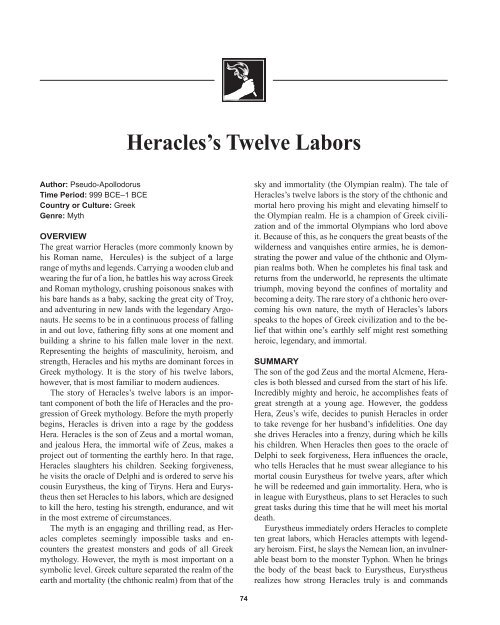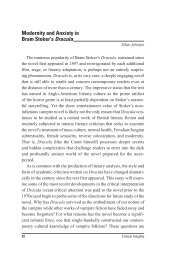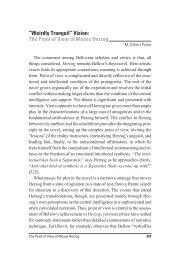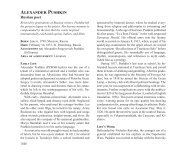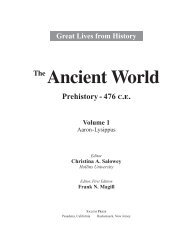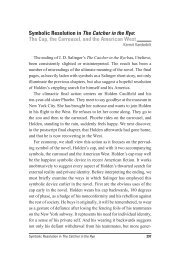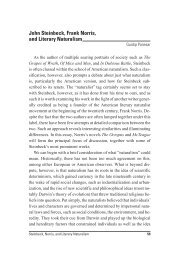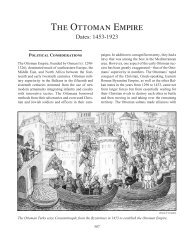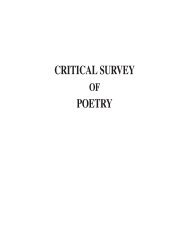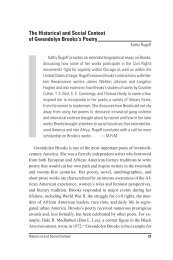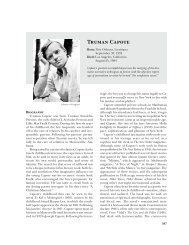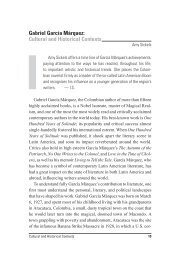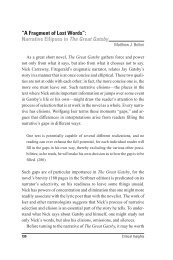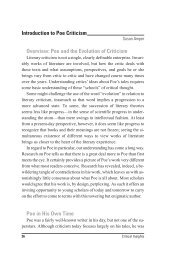Heracles's twelve labors - Salem Press
Heracles's twelve labors - Salem Press
Heracles's twelve labors - Salem Press
Create successful ePaper yourself
Turn your PDF publications into a flip-book with our unique Google optimized e-Paper software.
Heracles’s <strong>twelve</strong> <strong>labors</strong><br />
author: Pseudo-Apollodorus<br />
time Period: 999 BCE–1 BCE<br />
Country or Culture: Greek<br />
Genre: Myth<br />
OVERVIEW<br />
The great warrior Heracles (more commonly known by<br />
his roman name, Hercules) is the subject of a large<br />
range of myths and legends. Carrying a wooden club and<br />
wearing the fur of a lion, he battles his way across Greek<br />
and roman mythology, crushing poisonous snakes with<br />
his bare hands as a baby, sacking the great city of Troy,<br />
and adventuring in new lands with the legendary argonauts.<br />
He seems to be in a continuous process of falling<br />
in and out love, fathering fifty sons at one moment and<br />
building a shrine to his fallen male lover in the next.<br />
representing the heights of masculinity, heroism, and<br />
strength, Heracles and his myths are dominant forces in<br />
Greek mythology. It is the story of his <strong>twelve</strong> <strong>labors</strong>,<br />
however, that is most familiar to modern audiences.<br />
The story of Heracles’s <strong>twelve</strong> <strong>labors</strong> is an important<br />
component of both the life of Heracles and the progression<br />
of Greek mythology. Before the myth properly<br />
begins, Heracles is driven into a rage by the goddess<br />
Hera. Heracles is the son of Zeus and a mortal woman,<br />
and jealous Hera, the immortal wife of Zeus, makes a<br />
project out of tormenting the earthly hero. In that rage,<br />
Heracles slaughters his children. Seeking forgiveness,<br />
he visits the oracle of Delphi and is ordered to serve his<br />
cousin Eurystheus, the king of Tiryns. Hera and Eurystheus<br />
then set Heracles to his <strong>labors</strong>, which are designed<br />
to kill the hero, testing his strength, endurance, and wit<br />
in the most extreme of circumstances.<br />
The myth is an engaging and thrilling read, as Heracles<br />
completes seemingly impossible tasks and encounters<br />
the greatest monsters and gods of all Greek<br />
mythology. However, the myth is most important on a<br />
symbolic level. Greek culture separated the realm of the<br />
earth and mortality (the chthonic realm) from that of the<br />
sky and immortality (the Olympian realm). The tale of<br />
Heracles’s <strong>twelve</strong> <strong>labors</strong> is the story of the chthonic and<br />
mortal hero proving his might and elevating himself to<br />
the Olympian realm. He is a champion of Greek civilization<br />
and of the immortal Olympians who lord above<br />
it. Because of this, as he conquers the great beasts of the<br />
wilderness and vanquishes entire armies, he is demonstrating<br />
the power and value of the chthonic and Olympian<br />
realms both. When he completes his final task and<br />
returns from the underworld, he represents the ultimate<br />
triumph, moving beyond the confines of mortality and<br />
becoming a deity. The rare story of a chthonic hero overcoming<br />
his own nature, the myth of Heracles’s <strong>labors</strong><br />
speaks to the hopes of Greek civilization and to the belief<br />
that within one’s earthly self might rest something<br />
heroic, legendary, and immortal.<br />
SUmmaRY<br />
The son of the god Zeus and the mortal Alcmene, Heracles<br />
is both blessed and cursed from the start of his life.<br />
Incredibly mighty and heroic, he accomplishes feats of<br />
great strength at a young age. However, the goddess<br />
Hera, Zeus’s wife, decides to punish Heracles in order<br />
to take revenge for her husband’s infidelities. One day<br />
she drives Heracles into a frenzy, during which he kills<br />
his children. When Heracles then goes to the oracle of<br />
Delphi to seek forgiveness, Hera influences the oracle,<br />
who tells Heracles that he must swear allegiance to his<br />
mortal cousin eurystheus for <strong>twelve</strong> years, after which<br />
he will be redeemed and gain immortality. Hera, who is<br />
in league with eurystheus, plans to set Heracles to such<br />
great tasks during this time that he will meet his mortal<br />
death.<br />
eurystheus immediately orders Heracles to complete<br />
ten great <strong>labors</strong>, which Heracles attempts with legendary<br />
heroism. First, he slays the Nemean lion, an invulnerable<br />
beast born to the monster Typhon. When he brings<br />
the body of the beast back to eurystheus, eurystheus<br />
realizes how strong Heracles truly is and commands<br />
74<br />
MYTHHERO_Book.indb 74<br />
8/20/2013 2:14:01 PM
Heracles’s Twelve Labors │ 75<br />
“When Hercules [Heracles] asked Pluto<br />
[Hades] for Cerberus, Pluto ordered<br />
him to take the animal provided he mastered<br />
him without the use of the weapons<br />
which he carried. Hercules found him at<br />
the gates of Acheron, and, cased in his<br />
cuirass and covered by the lion’s skin,<br />
he flung his arms round the head of the<br />
brute, and though the dragon in its tail<br />
bit him, he never relaxed his grip and<br />
pressure till it yielded.”<br />
Bibliotheca<br />
that he never enter the city again and instead bring proof<br />
that he has completed each task to the city gates. Next,<br />
Heracles slays the Lernaean hydra, a nine-headed beast<br />
that had been killing cattle throughout the countryside.<br />
When he fights the monster, he realizes that for every<br />
head he cuts off, two more grow in its place, and so he<br />
instructs his nephew, Iolaus, to burn the necks to prevent<br />
new heads from growing back. Eurystheus, however,<br />
denies the success of this labor, as Iolaus had assisted<br />
Heracles in the battle.<br />
For his third labor, Heracles captures the Cerynitian<br />
hind, a beast precious to the goddess Artemis, after chasing<br />
it for an entire year. Next, he goes to capture the Erymanthian<br />
boar. While this task is simple compared to the<br />
others, Heracles stops to visit the centaur Pholus and,<br />
after being convinced to drink the wine that belongs to<br />
the other centaurs, finds himself in a bloody battle when<br />
those centaurs return. For his fifth labor, Heracles is ordered<br />
to dispose of the dung of the cattle of King Augeas<br />
in a single day. The son of a god, Augeas has seemingly<br />
endless cattle. After convincing the king to pay him for<br />
the work, Heracles redirects mighty rivers into the cattle<br />
yards, washing the dung away. However, Eurystheus rejects<br />
this labor on the grounds that Heracles received<br />
payment for completing it.<br />
For his sixth labor, Heracles chases away the birds<br />
of Stymphalus by clanging together castanets given to<br />
him by the goddess Athena. Next, he captures the Cretan<br />
bull, showing it to Eurystheus before letting it go free<br />
again. For his eighth labor, he captures the man-eating<br />
mares of King Diomedes, the son of the god Ares. In addition<br />
to slaying Diomedes and taking the mares, Heracles<br />
founds a new city on the grave of Abderus, who had<br />
been the mares’ caretaker before dying during the battle.<br />
For his ninth labor, Heracles goes to fetch the belt of<br />
Hippolyte, who is the queen of the Amazons, a community<br />
of fierce warrior women. On the way to Hippolyte,<br />
he slays a massive army that attacks his ships. Hippolyte<br />
at first offers the belt freely, but Hera, disguised as an<br />
Amazon, convinces the female army to attack Heracles,<br />
and so he is forced to kill them all. Next, Heracles travels<br />
a great distance and kills many people in order to<br />
fetch the cattle of Geryon, a monster with the body of<br />
three men.<br />
Eight years and one month after the start of the <strong>labors</strong>,<br />
Heracles finishes the tenth task. However, because<br />
he received help with the second labor and payment for<br />
the fifth, Eurystheus requires two more tasks of him.<br />
For his eleventh labor, Heracles must fetch the apples<br />
of the Hesperides from the ends of the earth, where they<br />
are guarded by the Hesperides themselves as well as an<br />
immortal dragon. Rather than steal the apples himself,<br />
however, he convinces the Titan Atlas to do so for him.<br />
Because Atlas has been punished by Zeus and tasked<br />
with holding up the sky, Heracles takes his position temporarily<br />
and tricks Atlas into holding the sky when he<br />
returns. Finally, Heracles enters the underworld itself<br />
to capture Cerberus, a three-headed hellhound with the<br />
tail of a dragon. After successfully wrestling the beast<br />
without using weapons, Heracles is allowed to bring it<br />
to the gates of Eurystheus, though he returns it shortly<br />
after. With this final labor complete, Heracles concludes<br />
his obligation to Eurystheus, having done exactly as the<br />
oracle of Delphi asked of him years before.<br />
Analysis<br />
The lyric poet Pindar, one of the most influential poets<br />
of ancient Greece, describes Heracles with the term<br />
hereos theos, meaning that he is both a hero and a god.<br />
This epithet captures the core of the myth that surrounds<br />
Heracles. Born to a mortal mother from her union with<br />
an immortal god, living as the greatest earthly hero before<br />
ascending to the heights of Mount Olympus, and<br />
at once cursed and blessed by the most powerful deities<br />
in the Greek pantheon, Heracles is the rare figure that<br />
transcends the divide between the realm of the mortals<br />
and that of the gods.<br />
MYTHHERO_Book.indb 75<br />
8/20/2013 2:14:01 PM
76 │ Trial and Quest<br />
As Heracles’s most famous myth, the story of the<br />
<strong>twelve</strong> <strong>labors</strong> offers a detailed exploration of how the<br />
mortal hero ascended to the heights of immortality.<br />
The world of Greek mythology was split between the<br />
chthonic realm and the Olympian realm. The term “chthonic”<br />
refers to things that are of the earth, which in<br />
Greek culture encompassed humanity, the underworld,<br />
death, monsters, and heroes. Temples were built to chthonic<br />
figures, particularly by cults devoted to heroes,<br />
and sacrifices were made at these locations prior to<br />
similar sacrifices to the gods. The Olympian realm, in<br />
contrast, was the fixed and relatively inflexible world<br />
of the sky, Mount Olympus, and the Greek pantheon.<br />
While mortals regularly entered the world of chthonic<br />
heroes after death, those worshipped in the Olympian<br />
realm never died, living on in the heights of the sky.<br />
The <strong>labors</strong> of Heracles, then, are the challenges that the<br />
mortal hero must overcome in order to become immortal,<br />
as declared by the oracle of Delphi. Because of this,<br />
the long list of battles and tribulations can be understood<br />
not as arbitrary wars with monsters and warriors but as<br />
one man triumphing above the chthonic realm, conquering<br />
earthly things with such might that he ultimately ascends<br />
as an Olympian deity.<br />
Although Heracles is not fully mortal in lineage<br />
(Zeus, his father, is the god of the sky and the most powerful<br />
force associated with the Olympian pantheon), it<br />
is important that from the start of his <strong>twelve</strong> <strong>labors</strong>, he<br />
is firmly and unambiguously a chthonic hero and not<br />
an extension of the Olympic world he champions. This<br />
is almost always the case for a figure born to a mortal<br />
mother and an immortal father, but in the instance of<br />
Heracles, it is particularly important to understand his<br />
mortality and his connection to the earth. The fact of his<br />
mortality is made clear first by the oracle, who declares<br />
that he can only become immortal by completing his<br />
vassalage to Eurystheus, and second by the scheming of<br />
Hera, who intends to kill him through the extremity of<br />
the <strong>labors</strong>. It is also, importantly, because of his chthonic<br />
origin that Hera torments him in the first place, angered<br />
by the insult of her divine husband taking a mortal<br />
woman as a partner. Heracles, then, is entirely of the<br />
earthly realm and, as such, fits in the long tradition of<br />
folk heroes in Greek and pre-Greek culture. His masculinity,<br />
skill as a warrior, sexual appetite (he has hundreds<br />
of partners, both male and female), and adventuresome<br />
spirit identify him as a typical Greek hero whose role is<br />
to protect and champion Greek civilization in the face<br />
of the chthonic threats of monsters, the natural world,<br />
and death. Through figures such as Heracles, the people<br />
of Greece could see their own triumph as the greatest<br />
people in the chthonic realm.<br />
The <strong>labors</strong> of Hercules, then, are <strong>labors</strong> in which<br />
Hercules conquers the chthonic realm to which he belongs,<br />
facing the most dangerous elements and monsters<br />
the world has to offer. His first task, that of killing the<br />
Nemean lion, makes this clear. The Nemean lion is the<br />
child of Typhon, the greatest of all the monsters in Greek<br />
mythology, and the grandchild of Gaia, the goddess of<br />
the earth itself and one of the few immortal deities to<br />
be associated with the chthonic. By facing the Nemean<br />
lion, Heracles is directly battling the ideal of the chthonic<br />
monster. It is important also that at this time in Greek<br />
history, lions had likely not been brought to the Greek<br />
state and instead had only been learned about through<br />
travels. Therefore, the Nemean lion with its invulnerable<br />
pelt also represents the fear of the unknown in the<br />
natural world, the rumor of great beasts outside the<br />
protection of Greek civilization. When Heracles tracks<br />
down this beast and defeats it, his triumph represents the<br />
triumph of all Greek people over the mysterious beasts<br />
and threats of foreign lands. A similar interpretation can<br />
be applied to the Lernaean hydra, the beast of the second<br />
labor and also a child of Typhon.<br />
The first labor also includes an important aside that<br />
helps define the meaning of Heracles’s quest. Before<br />
approaching the Nemean lion, Heracles comes across a<br />
man who is preparing to make his regular sacrifice to the<br />
beast. Heracles stops him, however, and insists that the<br />
man wait. If Heracles dies in battle, he instructs, the man<br />
should make the sacrifice to him as a hero. If Heracles<br />
succeeds, the sacrifice should be made instead to Zeus.<br />
Had Heracles perished, he would have fit neatly into<br />
the tradition of hero cults that celebrated many historical<br />
and legendary figures from the chthonic realm. Put<br />
another way, in death, his mortality would be official,<br />
thus making Heracles a hero. However, in conquering<br />
the beast, Heracles instead directs the man’s sacrifice toward<br />
Zeus and the Olympian realm. This is important in<br />
that while Heracles fulfills the trajectory of the hero and<br />
champions Greek society, he also transcends that role,<br />
directing the glory not to himself but to the gods. From<br />
the start, he is crossing the divide between the chthonic<br />
and the Olympian, acting as a champion of both realms<br />
at once.<br />
The first two <strong>labors</strong> having proven that Heracles is<br />
mighty enough to conquer any dangerous beast, the next<br />
<strong>labors</strong> test a different set of skills. Instead of vanquishing<br />
MYTHHERO_Book.indb 76<br />
8/20/2013 2:14:02 PM
Heracles’s Twelve Labors │ 77<br />
a fearsome monster, Heracles must capture a hind (deer)<br />
and a boar. While Eurystheus selects mystical versions<br />
of these animals, with the hind being faster than an arrow<br />
and the boar fearsome and strong, they are both animals<br />
that are the common objects of hunts. In capturing<br />
the boar and the hind, Heracles represents the success of<br />
mortals in conquering the natural world to provide food<br />
and sustenance for themselves. This is stressed through<br />
the fact that the hind is the sacred animal of Artemis, the<br />
goddess of the hunt, while the boar likewise roams in<br />
the forests that Artemis sometimes calls home. In capturing<br />
the hind, Heracles angers Artemis, who comes to<br />
stop him accompanied by her brother, Apollo. However,<br />
Artemis hears Heracles’s story and comes to approve,<br />
giving his mortal task the blessing of an immortal. This<br />
again blends together the chthonic and the Olympian,<br />
with Heracles’s success dependent on both his earthly<br />
skills and the blessing of the gods.<br />
The fourth and fifth <strong>labors</strong> involve side stories in<br />
which there is conflict between Heracles and centaurs,<br />
moments that heighten the tension between humanity<br />
and the natural world. Centaurs, in their half-human and<br />
half-horse form, often represent the link between civilization<br />
and wilderness. This dual nature makes centaurs<br />
seem monstrous to many humans in Greek mythology,<br />
especially as they seem to suggest that humans themselves<br />
might still have feral, unsophisticated elements to<br />
their being. Heracles encounters and, through violence,<br />
conquers this nature in both <strong>labors</strong>. In the fourth, he visits<br />
a centaur friend, Pholus, who in entertaining Heracles<br />
and offering him wine demonstrates that it is possible to<br />
overcome one’s beastly nature and embrace civilization.<br />
However, the other centaurs succumb to their wild roots,<br />
attacking Heracles and meeting their death. The other<br />
centaur to whom Heracles expresses affection is Chiron,<br />
a legendary teacher and giver of wisdom in Greek<br />
mythology. When Heracles inadvertently injures Chiron<br />
with an arrow, he rushes forth to remove the weapon,<br />
which suggests that even as he conquers the animal<br />
instinct of some centaurs, he still respects the wisdom<br />
available through the natural world and humanity’s own<br />
conflicted nature. Likewise, Heracles pauses during his<br />
fifth labor in order to kill a centaur who plans to take<br />
a human woman as a wife. This follows the labor in<br />
which Heracles cleans the massive stalls of a thousand<br />
cattle and demonstrates the dominance of domestication<br />
and farming over chthonic beasts. These two examples<br />
make clear the relationship between Heracles and the<br />
natural world: humans can gain wisdom from their own<br />
animal natures, but only if they conquer those natures<br />
and take care not to indulge them too fully (as in the<br />
carnal relationship suggested by the marriage between<br />
centaur and human).<br />
The risk of unleashing the wild nature of beasts within<br />
humanity is realized in the sixth, seventh, and eighth<br />
<strong>labors</strong>. In these tasks, Heracles captures first the violent<br />
Stymphalian birds, then the legendarily fierce bull of<br />
Crete, and finally the man-eating mares of the warrior<br />
king Diomedes. In every instance, Heracles successfully<br />
captures or defeats the animals. However, other myths<br />
reveal that the birds of Stymphalian go on to pester the<br />
legendary heroes known as the Argonauts. Similarly, the<br />
story of the seventh labor mentions that Heracles eventually<br />
sets the Cretan bull free, after which it begins to<br />
harass the people of the city of Marathon. These instances<br />
show that the beasts, even once conquered, can again<br />
wreck havoc if they are unleashed within civilization. In<br />
contrast, the flesh-eating mares are likewise released but<br />
instead make their way to Mount Olympus, the home<br />
of the gods. The beasts are quickly destroyed by the<br />
animals of the mountains, suggesting that the Olympian<br />
realm (in contrast to the chthonic realm) has nothing to<br />
fear from untamed wilderness.<br />
While the first eight <strong>labors</strong> pit Heracles against the<br />
beasts of the earth, the ninth and tenth <strong>labors</strong> amplify the<br />
danger and the level of his challenge. He has already, in<br />
diverse ways, proven his superiority over the greatest of<br />
monsters. However, he has not proven similar superiority<br />
over other humans, a necessary step if he is going<br />
to elevate himself to the status of the immortals. In the<br />
ninth labor, he battles the legendary Amazons, a group<br />
of fierce women warriors, as well as the armies of a<br />
number of other leaders and warriors. While at first Heracles’s<br />
reputation is such that Hippolyte, the ruler of the<br />
Amazons, offers him the belt requested by Eurystheus<br />
freely, Hera spreads discontent among the Amazons, resulting<br />
in the battle. These battles do not represent Heracles<br />
turning against or conquering human civilization,<br />
but rather serve to demonstrate his godlike superiority in<br />
military matters. The armies he slaughters are massive,<br />
yet the hero does not tire, pressing on toward victory.<br />
Heracles also challenges the core elements of the<br />
natural world in the ninth and tenth <strong>labors</strong>. Once again,<br />
this is a heightened conflict in comparison to what<br />
came before, emphasizing that Heracles is not only<br />
demonstrating superiority over untamed nature but<br />
also reaching total deification, which will separate him<br />
from the chthonic realm. During these <strong>labors</strong>, Heracles<br />
MYTHHERO_Book.indb 77<br />
8/20/2013 2:14:02 PM
78 │ Trial and Quest<br />
Myth into Art<br />
Widely considered the greatest artist of the Italian<br />
Renaissance, Michelangelo frequently drew inspiration<br />
from the myths of Greek antiquity. His drawing<br />
“Three Labors of Hercules” depicts the hero fighting<br />
with the Nemean lion, with Antaeus, and finally with<br />
the hydra. The drawing does not include the intense<br />
attention to detail that characterizes Michelangelo’s<br />
more famous works, such as the ceiling of the Sistine<br />
Chapel. However, it conveys the typically Renaissance<br />
sense of grandeur that defines the time period.<br />
Like many of his contemporaries, Michelangelo<br />
was interested in large, expressive, ornate art that<br />
inspired awe in its audience. He was drawn to sprawling<br />
narratives and dramatic details, such as the biting<br />
heads of the hydra and the torn mouth of the lion<br />
depicted in his drawing. In this sense, classical antiquity<br />
was a fertile source of inspiration for the artist.<br />
Stories such as the myth of Heracles’s <strong>twelve</strong> <strong>labors</strong><br />
are packed with action and grand themes, such as the<br />
struggle for immortality.<br />
In “Three Labors of Hercules,” Michelangelo draws<br />
not only from the narrative details of the Heracles<br />
myth but also from styles and poses from mythology.<br />
It was common in ancient times to carve sequences<br />
of drawings (often even of Heracles) onto sarcophagi<br />
or other objects or structures. The progression<br />
of poses Michelangelo selects here mimics many<br />
of those sequences as well as similar drawings of<br />
Heracles by other Renaissance painters and artists.<br />
While not rendered at the grand scale of some of his<br />
other works, Michelangelo’s drawing shows that the<br />
legendary hero was thrilling enough to capture the<br />
eye of one of the most gifted and dramatic artists of<br />
all time.<br />
comes into continual conflict with humans fathered and<br />
monsters formed by Poseidon, the god of the sea. Poseidon<br />
is associated with terrible floods and earthquakes,<br />
natural disasters that seemed to rise spontaneously from<br />
the earth to destroy civilization. When Poseidon sends<br />
sea monsters toward coastal cities during the <strong>labors</strong>,<br />
however, Heracles quickly destroys those monsters in<br />
battle. In a similar move, exhausted by the heat of the<br />
sun, Heracles turns his bow and arrow toward the sky.<br />
While he certainly cannot defeat the sun and the sky in<br />
battle, the god of the sun is pleased by Heracles’s courage<br />
and rewards him with a golden goblet in which to<br />
sail safely.<br />
With the original ten <strong>labors</strong> complete, Heracles has<br />
demonstrated his mastery over all aspects of the chthonic<br />
realm. He has killed the monsters of unknown<br />
lands, has domesticated the wildest beasts of Greece,<br />
has overcome the elements, and has vanquished entire<br />
armies. This mastery more than fulfills the qualifications<br />
for becoming a legendary hero and inspiring a chthonic<br />
cult. However, as the oracle has promised, Heracles is<br />
destined for an even greater place in mythology, and<br />
consequently, he must complete two more tasks that extend<br />
beyond the realm of the earthly hero.<br />
For the eleventh task, Heracles must fetch the apples<br />
from the garden of the Hesperides. This garden, located<br />
in the distant west, far away from Greece, is the property<br />
of Hera herself. In it, she planted an apple tree given<br />
to her by Gaia on the day of her wedding to Zeus.<br />
The fruit of this tree gives immortality to anyone who<br />
fetches it, but it is also guarded by an immortal dragon<br />
and by the Hesperides nymphs themselves. By claiming<br />
these apples, Heracles is essentially entering the<br />
realm of the gods, both trespassing into Hera’s sacred<br />
space and gaining for himself one route to immortality.<br />
However, as he is still a mortal hero, he cannot enter the<br />
garden himself. He seeks the assistance of Atlas, a Titan<br />
who has been condemned to spend eternity holding up<br />
the sky. Heracles momentarily takes the place of Atlas<br />
and symbolically becomes at once of the earth and of<br />
the sky, his body dividing the realms yet in contact with<br />
them both. It is by taking this position and acknowledging<br />
these dual roles that Heracles is able to obtain the<br />
apples. When Atlas returns, Heracles tricks him into resuming<br />
his position and is able to deliver the fruit to<br />
Eurystheus.<br />
While Heracles has completed this task, he has not<br />
actually gained immortality, and the apples are returned<br />
to the garden out of respect. Instead, it is through his<br />
final labor that he truly conquers death. In this labor,<br />
he must go into Hades (the underworld or the realm of<br />
death) and retrieve Cerberus, a monstrous hellhound<br />
MYTHHERO_Book.indb 78<br />
8/20/2013 2:14:02 PM
Heracles’s Twelve Labors │ 79<br />
with the tail of a dragon that guards the gates. Many<br />
figures in Greek mythology attempt to enter the realm of<br />
the dead, but very few successfully return to the world<br />
of the living. In entering this realm, Heracles confronts<br />
the greatest power in the chthonic realm and proves that<br />
he, like the Olympian gods, is unaffected by this danger.<br />
This is the true divide between the chthonic and the<br />
Olympian: it is not that the Olympian gods are reborn after<br />
death but rather that they do not die. Likewise, even<br />
if a hero is memorialized in temples and worshipped at<br />
festivals, he still faces a mortal death and is still sent to<br />
the underworld. Heracles overcomes this threat, traveling<br />
with the secrets of the Eleusinian cult and wrestling<br />
Cerberus. Heracles’s triumph over Cerberus suggests<br />
that even were he to find himself in Hades with the other<br />
mortal heroes, he would not be contained there, as his<br />
might is such that he could win his freedom at any time.<br />
To heighten this contrast, he comes across Theseus, the<br />
legendary chthonic hero and founder of Athens, who,<br />
unlike Heracles, is unable to escape the underworld.<br />
His <strong>labors</strong> complete, Heracles is free to go on to other<br />
adventures with the promise from the oracle that he will<br />
one day become immortal. Indeed, in later legends, his<br />
earthly body is destroyed in a funeral pyre he built himself,<br />
while his godly form rises to the immortal realm<br />
of the Olympians. However, the <strong>labors</strong> of Heracles<br />
themselves end long before he meets this destiny. The<br />
<strong>labors</strong>, then, are not about the existence Heracles will<br />
share on Mount Olympus, nor are they about immortality<br />
and godliness, even as those rewards drive the story<br />
from the start. Instead, the myth of the <strong>labors</strong> is about<br />
the triumph of Greek civilization over the untamed and<br />
often frightening natural world. Heracles is the greatest<br />
hero to come out of antiquity, a legend born in the<br />
chthonic realm. His greatest feat, however, is not simply<br />
his brutish triumph over beasts and monsters. Rather,<br />
his glory is the glory of all Greece, of the earth and of<br />
the gods. In directing sacrifices to Zeus and obeying the<br />
command of the oracle of Delphi, Heracles offers the<br />
devotion and respect expected from the chthonic realm.<br />
Paradoxical as it may seem, it is by becoming an ideal<br />
of chthonic life that Heracles is elevated at last to the<br />
Olympian realm, indicating that perhaps the two realms<br />
are not be as separate as they seem.<br />
Cross-Cultural Influence<br />
The ancient Greek Heracles was the pinnacle of the<br />
masculine hero, capable of conquering entire armies<br />
and slaughtering ferocious beasts. He fathered children<br />
with nearly a hundred women, traveled to the ends of<br />
the earth, and defended the entirety of Greek civilization<br />
on many occasions. However, the heights of Greek<br />
masculinity do not match up neatly with modern ideas<br />
of masculinity. The ancient Heracles was also a playful<br />
figure, enjoying leisurely games and spending time<br />
with his children when possible. In addition to his many<br />
wives, he took on countless male lovers to whom he<br />
expressed passionate, unabashed romantic love. In the<br />
ancient context, these qualities made him even more heroic<br />
and masculine, even if they seem incongruous with<br />
contemporary ideals of masculinity and heroism.<br />
Primarily because of his role as the ultimate hero,<br />
the myths surrounding Heracles have had a significant<br />
legacy through the modern day. Countless European<br />
and American films revisit the Heracles story, including<br />
the 1997 animated Disney musical Hercules and a long<br />
series of popular Italian adventure films from the midtwentieth<br />
century. Comic books, theatrical productions,<br />
and television series have also regularly featured Heracles.<br />
Almost without exception, however, these portrayals<br />
focus on a version of Heracles who fits comfortably<br />
into modern ideas of masculinity. He is presented as a<br />
stern or angry figure, quick to fight and lacking the playfulness<br />
and romanticism of the Greek myths. While he<br />
may rescue endangered strangers, as he does in the ancient<br />
stories of the <strong>twelve</strong> <strong>labors</strong>, the modern Heracles<br />
rarely falls in love with those strangers and even more<br />
rarely has his heart broken by them.<br />
One of the few contemporary exceptions to these<br />
portrayals is found in the book Autobiography of Red<br />
(1998) by the Canadian-born poet and classicist Anne<br />
Carson. A novel written in verse fragments, the work is<br />
a retelling of the tenth labor of Heracles, during which<br />
he battles the monster Geryon. Carson takes some inspiration<br />
from the ancient poet Stesichorus (Stesichoros),<br />
whose long poem Geryoneis tells the myth from Geryon’s<br />
perspective. While the Geryoneis is largely lost to<br />
time, existing only in a few fragments of text, those fragments<br />
inspired Carson to create a modern version of the<br />
myth that likewise tells the story from Geryon’s point of<br />
view. However, while the Geryoneis focuses on the violence<br />
of Heracles arriving at Erythea, the island where<br />
Geryon resides, and killing the supposedly immortal<br />
monster with a poisoned arrow, Carson instead imagines<br />
Geryon and Herakles (in her spelling) as young lovers,<br />
with Herakles abandoning Geryon and breaking his<br />
heart. In presenting Herakles as causing emotional rather<br />
than physical violence, Carson focuses the reader’s<br />
MYTHHERO_Book.indb 79<br />
8/20/2013 2:14:02 PM
80 │ Trial and Quest<br />
attention on a different aspect of the myths surrounding<br />
the legendary hero, highlighting the often romantic and<br />
sometimes tragic core of Greek mythology.<br />
The narrative of Autobiography of Red begins<br />
when Geryon is a young, sensitive boy, interested in<br />
art and close with his mother. While the mythological<br />
Geryon is a fiery beast with three heads and three<br />
sets of arms who is typically accompanied by his twoheaded<br />
hound, the Geryon of Carson’s story is a slight<br />
boy with beautiful red wings, hardly someone to be<br />
feared. Geryon’s early life is marked by tragedy when<br />
his older brother sexually abuses him, traumatizing the<br />
young boy and forcing him further into the seclusion<br />
of his mind. However, he begins to engage with the<br />
world again when a new boy, Herakles, arrives in town.<br />
Geryon almost immediately falls in love with Herakles,<br />
and the two have a brief affair until Herakles eventually<br />
abandons Geryon and leaves the town. The devastated<br />
Geryon retreats again into his mind. A few years<br />
later, he travels to Argentina, knowing that his lost love<br />
might be there. Geryon by chance encounters Herakles,<br />
who is accompanied by his new lover. The three men<br />
form a sort of love triangle, with the infatuated Geryon<br />
reaching out for brief moments of sexual contact and<br />
affection from Herakles. At the novel’s conclusion, the<br />
three travel to a famous volcano and stand at its molten<br />
edge, uncertain what to do with the complicated love<br />
that exists among them.<br />
The Carson version of the myth might seem, outside<br />
of a few telling details, nearly unrecognizable to audiences<br />
familiar with the tenth labor of Heracles. There is<br />
no violent battle, no command from Hera or promise of<br />
immortality to give the story a sense of importance or<br />
legendary inspiration. However, Carson is focused less<br />
on the narrative details of swordfights and monstrous<br />
hounds and more on the emotional core at the heart of<br />
much Greek mythology. In her own appended translation<br />
of the Stesichorus text, for instance, she includes<br />
a simple fragment announcing that “the red world And<br />
corresponding red breezes / Went on Geryon did not”<br />
(xv). These simple lines, presenting simply the information<br />
that Geryon has died, have an emotional and lyric<br />
intensity that makes that information into something<br />
deeply moving. Stesichorus, though engaged in a project<br />
very different from Carson’s, still saw the sense of<br />
loss and sadness present in the myth. Geryon at once<br />
belongs to the world, a place in which even the breeze is<br />
as red as he is, and is separate from that world, brought<br />
to death by Herakles. There is romantic and emotional<br />
depth to the myths of Heracles, Carson reminds the<br />
reader, even if modern versions of those myths rarely<br />
include those aspects.<br />
This moment of lyric intensity in the Geryoneis is<br />
the dominant mode in Carson’s modern version. Just as<br />
in Stesichorus’s text, Geryon is red, although this red<br />
marks him as different from, rather than part of, the<br />
world. Because of this, the young boy becomes obsessed<br />
with volcanoes and other fiery landscapes, seeing<br />
in them a home that he does not find in daily life. What<br />
remains the same, however, is the sense that the world<br />
itself has gone on while Geryon has not and that it is the<br />
fault of Herakles that this separation exists. After Herakles<br />
has broken the red boy’s heart, Geryon cries into the<br />
night, his voice “upcast to that custom, the human custom<br />
of wrong love” (75). Carson is deeply engaged with<br />
the sense that love itself, an experience so often idealized<br />
and treated as “right,” can in actuality be wrong<br />
(just as Heracles, in his righteous quest, is actually leaving<br />
great destruction and sadness in his wake). More<br />
than this, however, Carson notes that the experience of<br />
wrong love is itself a “human custom,” a tradition all<br />
humans experience. Because of this, the Geryon apart<br />
from the red world in the Geryoneis and the Geryon left<br />
heartbroken by Herakles in Autobiography of Red are<br />
in many ways one and the same, linked by that sense of<br />
abandonment and betrayal.<br />
The shift from physical violence to emotional violence<br />
is also appropriate in light of the history of Stesichorus<br />
himself. Stesichorus wrote many centuries after<br />
the myth of Heracles had become common. The story of<br />
the <strong>twelve</strong> <strong>labors</strong> was popular enough that even though<br />
most audiences could recall the details on their own,<br />
writers such as Stesichorus were able to tell their own<br />
versions, remaking a myth that had been remade many<br />
times before. In this context, Stesichorus shifted the perspective<br />
of the myth from Heracles to Geryon while also<br />
shifting the sympathies of the audience. Geryon, a supposedly<br />
immortal figure, is slaughtered by the singleminded<br />
and uncompassionate Heracles. The monster,<br />
in no uncertain terms, becomes a sympathetic victim.<br />
Likewise, Stesichorus breaks apart the traditional metrical<br />
qualities of Greek poetry, creating a new rhythmic<br />
form in order to tell the myths in an unfamiliar and<br />
surprising manner. Carson, in writing a novel in verse,<br />
maintains this tradition. The Herakles and Geryon she<br />
creates are both familiar and unfamiliar, just as the poetic<br />
fragments of her novel are both recognizable and<br />
unusual. By basing this narrative off the Stesichorus<br />
MYTHHERO_Book.indb 80<br />
8/20/2013 2:14:02 PM
Heracles’s Twelve Labors │ 81<br />
fragments, she reminds her readers that such revision of<br />
classic myths is not a betrayal of the originals but rather<br />
a continuation of an ancient tradition in which writers<br />
keep stories alive by telling them in new ways.<br />
This sense of connection through revision, of understanding<br />
the past by engaging with the contemporary<br />
world, resonates throughout Autobiography of Red. A<br />
large array of myths and legends have persisted through<br />
the centuries, and while figures such as Heracles seem<br />
to dominate these cultural traditions, unchanged after<br />
all that time, they are in actuality always remade, their<br />
narratives and meanings shifting. When the Herakles of<br />
Autobiography of Red brags that he is “a master of monsters”<br />
(129), the meaning of his declaration is heightened<br />
and complicated by humankind’s many cultural<br />
legacies. What does it mean to hold power over another<br />
person, whether through physical strength or emotional<br />
dependency? How do humans make monsters out of<br />
one another, and when does the monster actually deserve<br />
sympathy and understanding? Who is the hero:<br />
the dashing and powerful warrior, the sensitive and kind<br />
monster, or both? Questions such as these, nestled at the<br />
heart of the <strong>labors</strong> of the Heracles, are deep and complicated<br />
enough that they draw readers in today just as<br />
they did thousands of years ago. As much as Heracles<br />
himself might seem a bundle of contradictions and Carson’s<br />
version of the myth a departure from the intent<br />
of the original narrative, it is the availability of these<br />
different interpretations that makes the legendary hero<br />
so much more than a mighty warrior with a quest for<br />
immortality.<br />
T. Fleischmann, MFA<br />
Bibliography<br />
Burkert, Walter. Greek Religion. Cambridge: Harvard<br />
UP, 1985. Print.<br />
Carson, Anne. Autobiography of Red. New York: Vintage,<br />
1999. Print.<br />
Curtis, Paul. Stesichoros’s Geryoneis. Leiden: Brill,<br />
2011. Print.<br />
Genovese, E. N. “Hercules and His Twelve Labors.”<br />
Masterplots. 4th ed. Ed. Laurence W. Mazzeno. Pasadena:<br />
<strong>Salem</strong>, 2010. Print.<br />
Hirst, Michael. Michelangelo and His Drawings. New<br />
Haven: Yale UP, 1988. Print.<br />
Miller, Geordie. “Shifting Ground.” Canadian Literature<br />
210–211 (2011): 152–67. Print.<br />
Morgan, Pauline. “Hercules and His Twelve Labors.”<br />
Cyclopedia of Literary Places. Ed. R. Kent Rasmussen.<br />
Pasadena: <strong>Salem</strong>, 2003. Print.<br />
Murray, Stuart J. “The Autobiographical Self: Phenomenology<br />
and the Limits of Narrative Self-Possession<br />
in Anne Carson’s Autobiography of Red.” English<br />
Studies in Canada 31.4 (2005): 101–22. Print.<br />
Pseudo-Apollodorus. The Library. Trans. J. G. Frazer.<br />
1921. Cambridge: Harvard UP, 1996. Print.<br />
MYTHHERO_Book.indb 81<br />
8/20/2013 2:14:02 PM


